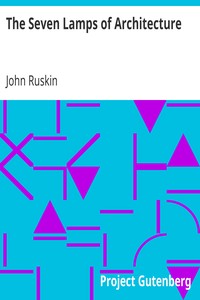The Seven Lamps of Architecture by John Ruskin
"The Seven Lamps of Architecture" by John Ruskin is an architectural manifesto written in the mid-19th century. The work is structured as a series of essays that discuss fundamental principles guiding architecture, particularly through the metaphor of "lamps" symbolizing different values. Ruskin's goal is to elevate architecture beyond mere construction to an art form that embodies spiritual, moral, and aesthetic ideals. At the start of the text, Ruskin provides a preface and
introduction, outlining his approach to architectural criticism. He distinguishes between building and architecture, emphasizing that the latter should convey beauty and deeper meanings rather than just fulfill practical functions. Ruskin reflects on his observations of medieval architecture, lamenting the decline in artistic values in contemporary practices. He introduces the concept of the "Lamp of Sacrifice," indicating that true architecture demands personal sacrifice and dedication to beauty and truth, fundamentally opposing the cost-cutting mindset dominant in his time. Through this engaging opening, he sets the stage for a profound exploration of architectural ethics and aesthetics. (This is an automatically generated summary.)
Read or download for free
| How to read | Url | Size | |||
|---|---|---|---|---|---|
| Read now! | https://www.gutenberg.org/ebooks/35898.html.images | 520 kB | |||
| EPUB3 (E-readers incl. Send-to-Kindle) | https://www.gutenberg.org/ebooks/35898.epub3.images | 3.0 MB | |||
| EPUB (older E-readers) | https://www.gutenberg.org/ebooks/35898.epub.images | 3.1 MB | |||
| EPUB (no images, older E-readers) | https://www.gutenberg.org/ebooks/35898.epub.noimages | 262 kB | |||
| Kindle | https://www.gutenberg.org/ebooks/35898.kf8.images | 2.1 MB | |||
| older Kindles | https://www.gutenberg.org/ebooks/35898.kindle.images | 2.1 MB | |||
| Plain Text UTF-8 | https://www.gutenberg.org/ebooks/35898.txt.utf-8 | 478 kB | |||
| Download HTML (zip) | https://www.gutenberg.org/cache/epub/35898/pg35898-h.zip | 6.3 MB | |||
| There may be more files related to this item. | |||||
Similar Books
About this eBook
| Author | Ruskin, John, 1819-1900 |
|---|---|
| Title | The Seven Lamps of Architecture |
| Note | Reading ease score: 50.9 (10th to 12th grade). Somewhat difficult to read. |
| Note | Wikipedia page about this book: https://en.wikipedia.org/wiki/The_Seven_Lamps_of_Architecture |
| Credits |
Produced by The Online Distributed Proofreading Team at http://www.pgdp.net |
| Language | English |
| LoC Class | NA: Fine Arts: Architecture |
| Subject | Architecture |
| Category | Text |
| EBook-No. | 35898 |
| Release Date | Apr 18, 2011 |
| Copyright Status | Public domain in the USA. |
| Downloads | 1362 downloads in the last 30 days. |
| Project Gutenberg eBooks are always free! | |


